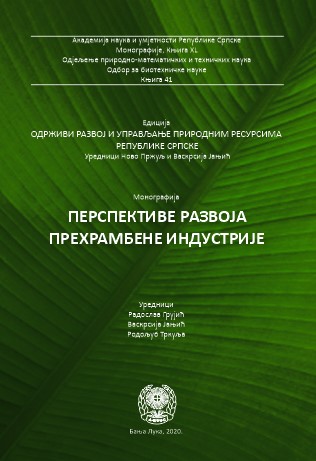Technology of functional dairy products
DOI:
https://doi.org/10.7251/EORU2002285SKeywords:
Functional food, Dairy products, Probiotics, PrebioticsAbstract
Milk and dairy products are main constituents of daily diet due to its nutritive characteristics and health benefits. Milk, known as a good source of proteins, fats, and major minerals, is considered as a nearly complete food with significant amount of biologically active components. Thus, all the mentioned benefits about milk labeled milk and dairy products as a functional food. Milk is a complex mixture of a broad variety of bioactive substances such as essential amino acids, fatty acids, carbohydrates, minerals, vitamins, enzymes and etc. Consumer’s interest about balanced nutrition and personal health are reasons of increased consumption of functional dairy products, targeted for special consumer groups (age and health condition). Progressive scientific research and creation of new functional ingredients followed by application of new technologies, open various opportunities for production and market of functional dairy products. Nowadays, the high demand for products with lower content of fat and higher content of easy to digest proteins, tailor variety of new diary low fat products, enriched with minerals and vitamins, hydrolyzed lactose or proteins for specific consumer groups. Besides of that, it has been noticed an increasing trend in consumption of different types of fermented dairy products, characterized by optimized texture and flavor and addition of various components such as probiotics and prebiotics, whey proteins in form of isolates or concentrates, and other different components (powder milk, skimmed powder milk, whey powder, skimmed whey powder, natural sugar etc.). Different fermented dairy products can be produced according to the chosen strain used during fermentation. In production of plain traditional yoghurt traditional thermophilic bacteria Streptococcus thermophilus and Lactobacillus delbrueckii subsp. bulgaricus were used. Introduction of new species of probiotic bacteria originated from Lactobacillus and Bifidobacterium led to significant progress in modern technology of fermented dairy products. The probiotic species from Lactobacillus and Bifidobacterium possess beneficial effect on human health and they were known as a part of human intestines microbiome. However, the most often used as a starter culture in modern production of fermented dairy products are lactic acid bacteria (LAB). In yoghurt production, besides the traditional and probiotic cultures, other starter culture can be used such as bacteria Lactobacillus lactis, Lactococcus lactis, Leuconostoc spp., or different yeast species, individually or in a chosen combinations. Despite the fact that fermented goat beverages were not sufficiently researched, production of these beverages has been getting more attention due to therapeutic characteristics of goat milk. Additionally, when fermented goat milk is enriched with probiotic bacteria and prebiotic supplements such as inulin, it meets the level of functional food standards. Beany taste of soya milk, as a main disadvantage of soy products, can be masked during the fermentation followed by reduced level of oligosaccharides, raphinosis and stachyoses. Due to this, fermented soy products are in consumer’s demand and are getting more attention. Soya milk is usually fermented with lactic acid bacteria (LAB), specific mold species or probiotic bacteria. Considering the well-known role and health benefits of dairy products that are constantly developing into new and improved generation of products with advanced functional properties and high nutritional value, it is understandable that dairy products are progressively gaining established scientific credibility.
